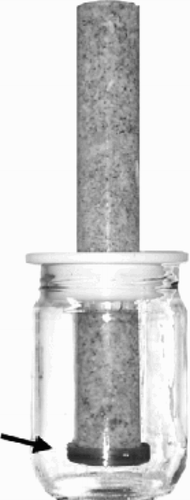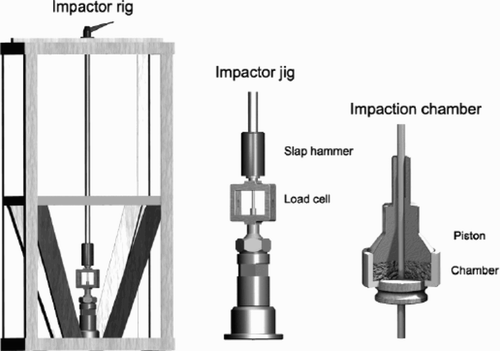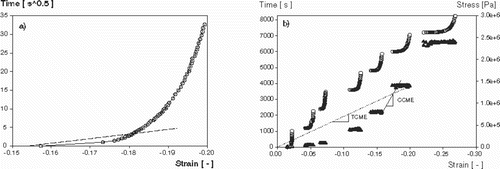Figures & data
Figure 1. Flow chart of study logistics from intact bone to production of morsellized bone, the preparation of different water and fat modifications, and the construction of bone pellets by the standard impaction routine applied to each of the 32 pellets.Dotted lines indicate on which levels measurements were performed.ICME:impaction constrained modulus of elasticity;AMD:apparent mass density;CCME:consolidated constrained modulus of elasticity;TCME:total constrained modulus of elasticity; BMD: bone mineral density.

Figure 2. Fat separator consisting of a perpendicular Plexiglas cylinder filled with morsellized bone. Fat is drained by gravity through a stainless steel mesh at the bottom (arrow). To facilitate fat drainage by reducing viscosity, the separator was kept in an incubator (40°C).

Figure 3. The impactor rig assembled (left). The impactor jig (middle picture) shows the sliding hammer, load cell, piston and bone chamber, kept in line by a central rod. Strain gauges are attached to the vertical bars of the load cell. The sliding hammer strikes the top of the load cell. Strain gauges record the deformation of the passing energy wave, before it compresses the morsellized bone in the bone impaction chamber (right) under the piston. Deformation of the load cell is dependent on the energy mass and stiffness of the bone material.

Figure 4. Strain-time progress (○) at load level 1,400 N for one native bone pellet (graph a) illustrates the theoretical duration of the consolidation period based on Taylor's construction (broken line). Strain-stress progress (▴) for all load levels (graph b) indicates the relationship between consolidated and total constrained modulus of elasticity (CCME and TCME) of the impacted bone. CCME is the slope of the initial deformation during consolidation at load level 1,400 N, while TCME indicates the slope of total deformation lapse from zero to 1,400 N. CCME is by far the highest. Incompressible fluids govern the deformation before the pellet is drained and consolidated.

Table 1. Water and fat distribution as measured in loose bone and impacted bone. A hyphen indicates that no material was analyzed
Table 2. Relationship of outcome values after impaction of loose bone with 5 different fluid concentrations into bone pellets. Mean values are given with standard deviation values in parentheses